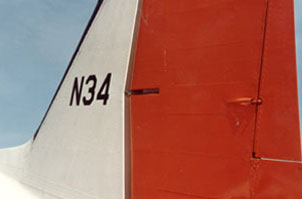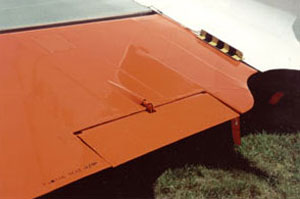- The original paint changed dramatically for a good many reasons.
Though we rely heavily on structured paint references such as the american
FS paint chips or the british Methuen standards, it is not nearly so
cut and dried in the real world. Different paint manufacturers had different
interpretations of the official colour charts - if there were any -
and different paints weathered in different ways. Anybody who has owned
a white car knows just how many variations of white there are when it
came time to buy a spray can of touchup paint. And during wartime official
standards sometimes went out the window due to lack of supply of the
correct paint. Ground crews often painted aircraft with whatever paint
they had to hand and it may or may not have been the "correct" colour.
How can it be said that olive drab paint must be lightened with 20% white for a 1/72 scale model when the paint on full size aircraft may change that much or more from aircraft to aircraft? Which shade do you lighten, the factory fresh olive drab on a P-40B built by Curtiss in 1940, or the weathered olive drab on a P-51B built by North American in 1943? - Taking samples from original paint on museum examples is also unreliable. Paint oxidizes, fades, and gets dirty over the years. Austro-Hungarian WW1 aircraft are a good example. For years it was thought that some were painted in the so-called "Autumn Leaf" camouflage - red/brown and green hexagonals painted over a mustard yellow base. Recent chemical analysis has shown that the paints used were actually three different shades of gray, and that the paint and overcoat of varnish had oxidised over the years and turned into the "Autumn Leaf" colours.
- I think it's safe to say that most of us work from photographs of
the real object we're modelling, even with modern subjects - it's just
not practical or possible to visit airfields all the time to match up
paint colours, and that just isn't an option for most historic aircraft
unless you have access to a time machine. If anyone out there does by
the way please let me know - I'd love to borrow it someday just to see
if anybody really was on that grassy knoll in 1963. But I digress....
Photographs bring a whole new set of variables into the equation. Different film, different cameras, different lighting, different labs developing the film. Even two photos taken from different angles will show the same paint differently due to refraction. It all adds up to incredible variations in colour.

Same DC-3, same red paint, same distance away, same camera, same roll of film developed by the same lab, two different angles. Which red are you going to use as the starting point for your scale colour? (photos by Gordon Parker) - The hobby paints we are using vary immensely. When painting the cockpit
of my Hasegawa Tomcat,
I compared paints from Testors, Humbrol, Aeromaster and Gunze Sangyo.
All purported to be FS 36320 yet they were all quite different from
each other. And none of them matched any of the colour photos I had
of Tomcat cockpits! In other words, why change the colour of paint by
a certain pre-ordained amount simply because it's an "out of the bottle"
colour? It could very well be the wrong shade to begin with and lightening
it will only exacerbate the error!
As an interesting aside, I have several of the same shades of paint from both Aeromaster and Polly Scale. Both brands are, as you probably know, manufactured by Floquil and are, for all intents and purposes, the same paints in different bottles. Aeromaster boasts that its paints are lightened for "scale effect" while Polly Scale makes no such claims - yet they are exactly the same shades! Hmmm.... Aeromaster, I might add, annoyed me to no end with its insistance on the use of scale colour for its decal sheets. Their Japanese markings in particular were far too orange and really bore little resemblance to bright red hinomarus. Also the red in some of their british roundels looked closer to pink than a brick red. Neither of them looked "right" to my eye. - Lighting and weather conditions can affect colour perception immensely. An aircraft viewed in a poorly lit hangar on a dull day will look completely different out in bright sunshine. Similarly, a model lit by a 60 watt desk lamp will appear to be a very different colour than when viewed by fluorescent light, or by natural light.
- If we take it to the nth degree, wouldn't 1/700 scale ships be almost white? Not to mention that all the colours would all end up the same monotone shade. Just spray the whole thing; propellers, hull, decks, superstructure, aircraft - everything - a very pale gray or off-white and be done with it. It would certainly simplify the painting process, wouldn't it?
- Finally, and to me the paramount reason, I don't for a second look at the models on my shelf and think of them as the real thing 72 feet away! Call it cynicism, call it a lack of imagination, but I just can't suspend my disbelief that much - nor do I particularly want to. They are miniature representations of the full size object. I try to be as accurate as I can when building and painting them, but my idea of accurate does not extend to dubious colour changes based on hypothetical atmospheric conditions and viewing distances! Models I've seen completed according to scale colour "rules" looked like nicely faded and weathered aircraft but they didn't look any more like the real thing parked 72 feet away than the rubber toy in the original "King Kong" did a giant ape. They looked like models with faded paint. Sorry....
If we are so concerned with capturing the look of the full sized article so precisely, then really one must factor in all the variables and model a very specific point in time and space, taking into consideration all of the above points - viewing distances and angles, lighting, weathering, full size paint, model paint, photographic qualities, etc., etc. In other words, your P-51 may be finished as it appeared when viewed at high noon on a sunny spring day and from a distance of exactly 72 feet and the paint should have been factory applied less than two months ago which means that it has weathered x amount since then and has been washed x amounts of times and of course you're seeing it with your own eyes and not looking at a vintage colour photo and you're starting with a model paint that has been exactly matched to the original, and, and.... Sound ridiculous? And lightening your paint to represent a set viewing distance doesn't?!? Obviously it's an impossibility and frankly, even if you could pull it off, you'd end up with a model that was no more "realistic" than one that was finished with straight-out-of-the-bottle paints. Why? Because it's a model dammit!! And furthermore, the chances of comparing your model to the real thing viewed under extremely precise conditions are about the same as your chances of winning the lottery, bedding Naomi Campbell and curing cancer all on the same day - it ain't gonna happen!!!!